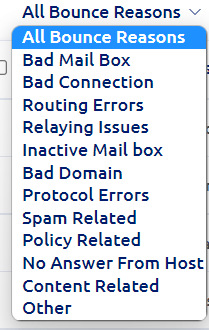A bounce is a response from a mail server or mailbox provider informing sender or sending mail server that an email wasn’t delivered. When an email bounces, it didn’t reach to the recipient’s inbox instead, the mailbox provider returned it to the sender with an error message.
Please note that there are some bounces that you can fix, while there are others that cannot be fixed. Please be sure to check the spelling of the email address to ensure there are no typos.

Bounces are divided in two categories:
- Hard bounces
- Soft bounces
Hard Bounce
A permanent failure where an email server will not try to send the email, until resolved.
- Bad-domain: the domain of the email address (for example ‘@example.com’) is not valid. In this case, domain must be checked for validity as well as typo errors.
- Bad-mailbox: the email address doesn’t exist on the server. Either mailbox doesn’t exist, or a typing error has been made by sender.
- Inactive-mailbox: the email address used to exist but has become deactivated, mailbox has been deactivated or removed.
- Invalid-sender: the receiving domain does not like the IP or domain sending the email. Sender is either marked in a blocklist or has previously been marked as spam sender from various mail service providers.
- Policy-related: a catch-all category, often indicating the sender is on a blacklist or any other policy set on recipient server side.
- Relaying-issues: Sender email is not allowed from a sending server. Sender email needs to be authenticated from parent mail service.
If your email bounces due to bad or inactive mailbox, communicate with your contact on other channels to update the email address.
Soft Bounce
A transient failure where an email server will try to send email after current delivery failure.
- Mailbox is full: All mail providers limit mailbox size to a certain point. Gmail, for example, gives its users 15GB of free storage while Yahoo! provides their users with 1TB of storage space. Microsoft has a limit for outlook users 15 to 20GB and Microsoft 365 user has 50GB. Once a user hits the limit, their mail provider won’t accept new messages and messages will bounce.
- Delays or temporary issues on the receiver side: This happens when recipient mail server is receiving a heavy load of traffic that can prevent emails from getting delivered. This bounce tells us that messages are not being accepted right now but might have success delivering this same message after multiple retries. Mail servers retry to send email automatically based on their retry settings.
- Content-related soft bounces: Recipient server might choose to bounce individual emails if your content looks suspicious. An immediate action should be taken on this error, as this can lead to permanent blockage of sender & sending IP.
- Spam or reputation-related soft bounces: In addition to email content, recipient servers or mail providers use other tools to decide whether you’re a trustworthy sender. If they’re suspicious of your sending reputation, they might decide to bounce your emails.
- Routing errors: The connection between sender and recipient mail servers got disconnected before the emails were delivered, or any network related errors fall in this category.
If your email bounces due to content or spam-related issues, review the campaign content and links; refine with more subtle calls to action. You can also ask the contact to add you to their safe senders list or add your email address to their contacts.
Please review the Tracking and Cleaning Bounced Emails and Campaign Report articles for more information.
